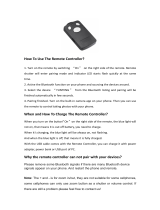
Connecting to Trusted Devices
You can designate a connected device as trusted and keep your Xperia™ device
unlocked while connected. If you have a device that you connect to regularly using
Bluetooth® or NFC, for example, a home entertainment system or a fitness tracker, you
can add it as a trusted device and bypass the added security of the lockscreen to save
time. This feature is suitable if you’re normally in a relatively secure place when you use
these devices. In some cases, you may still need to manually unlock your device before a
trusted device can be connected.
It is not recommended to add devices that are constantly connected to your device as trusted
devices, such as Bluetooth® keyboards or cases.
As soon as a trusted device is switched off or moves out of range, your screen locks and you
need your PIN, pattern or password to unlock it.
To Add a Trusted Bluetooth® Device
1
Make sure your device is paired and connected to the Bluetooth® device that you
want to add as a trusted device.
2
Find and tap Settings > Lock screen & security > Smart Lock.
3
In the Smart Lock menu tap Trusted devices > ADD TRUSTED DEVICE >
Bluetooth
4
Tap a device name to select it from the list of connected and paired devices, then
tap
YES, ADD
5
Depending on the security of your connection, you may need to manually unlock
your device before the trusted device can keep it unlocked.
To Remove a Trusted Bluetooth® Device
1
From your
Home screen
, tap
.
2
Find and tap Settings > Lock screen & security > Smart Lock > Trusted devices.
3
Tap the device you want to remove.
4
Tap Remove trusted device.
To Add a Trusted NFC Device
1
Make sure your device is paired and connected to the Bluetooth® device that you
want to add as a trusted device.
2
Find and tap Settings > Lock screen & security > Smart Lock.
3
Tap
Trusted devices
>
ADD TRUSTED DEVICE
>
NFC
.
4
Follow the on-screen instructions.
Making Sure You're Secure when Using Trusted Devices
Different Bluetooth® devices support different Bluetooth® standards and security
capabilities. There's a chance someone could keep your Xperia™ device unlocked by
imitating your Bluetooth® connection, even if your trusted device is no longer nearby.
Your device is not always able to determine whether your connection is secure from
someone trying to imitate it.
When your device can't determine whether you're using a secure connection, you'll get a
notification on your Xperia™ device and may need to manually unlock it before the
trusted device can keep it unlocked.
Bluetooth® connectivity range can vary depending on factors like the model of your device,
the connected Bluetooth® device, and your environment. Depending on these factors,
Bluetooth® connections can work over distances up to 100 meters.
Connecting to Trusted Places
When the Trusted places feature is set up, the lockscreen security on your Xperia™
device gets disabled when you are in a designated trusted location. For this feature to
work, you must have an internet connection (preferably over Wi-Fi) and allow your device
to use your current location.
14
This is an internet version of this publication. © Print only for private use.





















